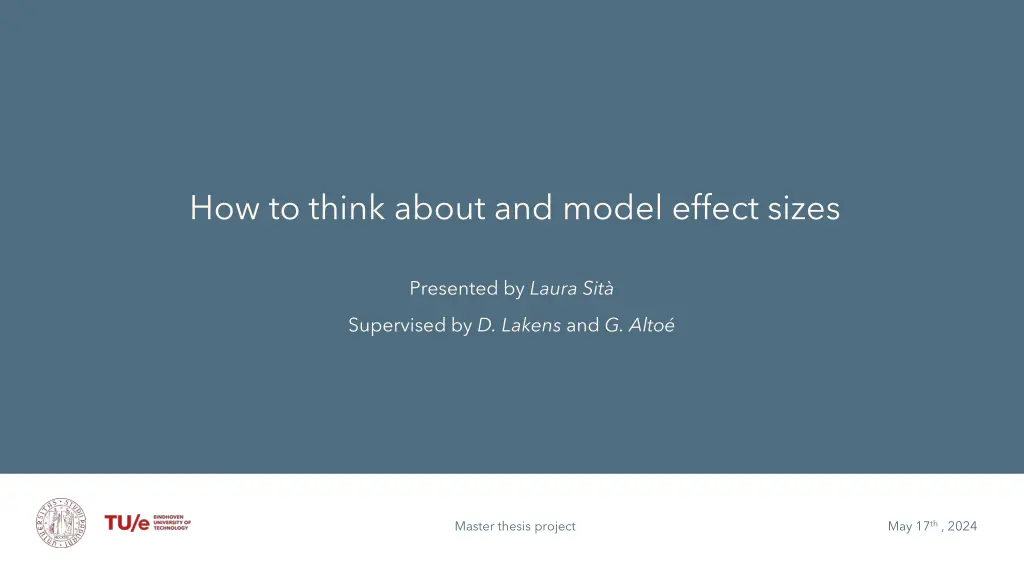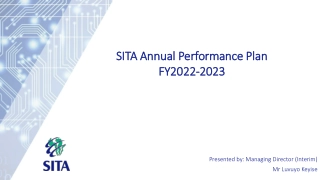
Modeling Effect Sizes in Research
Learn about the importance of effect sizes in research, the types of effect sizes, and common misinterpretations. Discover new solutions proposed by authors to address issues with effect size reporting. Explore how to think about and model effect sizes effectively for a more robust interpretation of research findings.
Download Presentation

Please find below an Image/Link to download the presentation.
The content on the website is provided AS IS for your information and personal use only. It may not be sold, licensed, or shared on other websites without obtaining consent from the author. If you encounter any issues during the download, it is possible that the publisher has removed the file from their server.
You are allowed to download the files provided on this website for personal or commercial use, subject to the condition that they are used lawfully. All files are the property of their respective owners.
The content on the website is provided AS IS for your information and personal use only. It may not be sold, licensed, or shared on other websites without obtaining consent from the author.
E N D
Presentation Transcript
How to think about and model effect sizes Presented by Laura Sit Supervised by D. Lakens and G. Alto Master thesis project May 17th, 2024
Outline 01 02 03 04 Introduction Research and objectives Methodology Conclusions Master thesis project May 17th, 2024
3 01 Introduction
01 Introduction 4 A measure of effect size effect size is a quantitative description of the strength of a phenomenon It indicates whether an intervention or experimental manipulation has an effect greater than zero or how big the effect is Laura Sit / Master thesis project May 17th, 2024
01 Introduction 5 For unstandardized effect sizes unstandardized effect sizes, the effect size is expressed on the scale that the measure was collected on To facilitate a comparison of effect sizes across situations where different measurement scales are used Standardized effect sizes, Standardized effect sizes, which can be grouped in two families: the d family (consisting of standardized mean differences) - the r family (measures of strength of association) - Laura Sit / Master thesis project May 17th, 2024
01 Introduction 6 Here is an example of a visualization of two groups ( population blue and population pink ) representing Cohen's d = 1.50 Laura Sit / Master thesis project May 17th, 2024
01 Introduction 7 Effect sizes are underappreciated and often misinterpreted Effect sizes are underappreciated and often misinterpreted Common mistakes are to describe the effect size in ways that are uninformative (e.g. arbitrary standards set by Cohen) small, medium, large compared to what/for what purpose? Looking up the function cohen.d of the r-package {effsize} on the Help: Laura Sit / Master thesis project May 17th, 2024
01 Introduction 8 Some authors have recently suggested new solutions Some authors have recently suggested new solutions HILGARD HILGARD ( (2021 Some effect sizes are too large Suggestion. The largest plausible effect size is an empirical estimate of how big is too big: effects that exceed this limit are implausible and should be viewed with skepticism 2021) ) FUNDER FUNDER AND Effect sizes are often misinterpreted: the most common mistakes is to describe them in ways that are uninformative (e.g., using arbitrary standards) or misleading Suggestion. Effect sizes can be usefully evaluated by comparing them with well- understood benchmarks AND OZER OZER ( (2019 2019) ) Laura Sit / Master thesis project May 17th, 2024
9 02 Research and objectives
02 Research and objectives 10 This project aims to This project aims to 1. suggest a better solution to think about effect sizes 2. show how to implement it in research Achieving these objectives would lead to a theoretically more meaningful way to interpret effect sizes a theoretically more meaningful way to interpret effect sizes think about practical importance of the effect size Laura Sit / Master thesis project May 17th, 2024
02 Research and objectives 11 1. A better solution to think about effect sizes 1. A better solution to think about effect sizes Researchers should explicitly variable on the dependent variable and consequently test it through their hypotheses explicitly model model the predicted effect of the independent We feel that modelling would prevent researchers finding effect sizes too big to be true (as Hilgard pointed out) implicitly assuming that the relationship between variables is linear (e.g. in power analysis) Laura Sit / Master thesis project May 17th, 2024
02 Research and objectives 12 1. An example of explicitly modelling the relationship 1. An example of explicitly modelling the relationship In order to test their prospect theory, Tversky and Kahneman proposed a model showing the intensity of the manipulation as a s-shaped and asymmetrical function They hypothesized that the value function is steeper for losses than gains indicating that losses outweigh gains Laura Sit / Master thesis project May 17th, 2024
02 Research and objectives 13 2. How to implement models in research 2. How to implement models in research When it comes to design a study, we suggest psychologists to think about variables research the literature in order to find what could be the effect of their manipulation create create a a model model representing representing the the expected expected effect formulate an hypothesized effect size that tests the model effect size size Once having (simulated and then) analyzed the data compare the initial model (from expectations) to the one that describes the observed effect size interpret the comparison (e.g. if they differ, try to understand why) Laura Sit / Master thesis project May 17th, 2024
14 03 Methodology
03 Methodology Data simulation 15 Data simulation using the statistical software R Data simulation using the statistical software R Laura Sit / Master thesis project May 17th, 2024
03 Methodology Data simulation 16 m = 0.474 sd = 1.353 d = 0.473 m = 0.359 sd = 1.434 d = 0.25 Effect of x on y Effect of x on y Laura Sit / Master thesis project May 17th, 2024
03 Methodology Data simulation 17 How the manipulation is translated into an effect of the dependent variable Laura Sit / Master thesis project May 17th, 2024
03 Methodology Data simulation 18 m = 2.032 sd = 3.016 d = 0.674 m = 0.474 sd = 1.353 d = 0.473 Effect of x on y Effect of x on y Laura Sit / Master thesis project May 17th, 2024
03 Methodology Data simulation 19 How the manipulation is translated into an effect of the dependent variable Laura Sit / Master thesis project May 17th, 2024
03 Methodology Data analysis 20 Empirical component of the project: analysis of a real data set Empirical component of the project: analysis of a real data set 1 1. . Find Find a a open data are accessible a manipulation is done and a manipulation check is measured the dependent variable is related to the manipulation through some psychological mechanism open- -access access study study where where 2 2. . Create Create a a plot highlights the relationship between the two distributions of data (subjects responses for the manipulation check and the dependent variable) represents the links between each couple of responses within every subject plot that that 3 3. . Expect Expect to a correspondence within each couple of data that would be graphically represented by a series of straight lines to find find Laura Sit / Master thesis project May 17th, 2024
03 Methodology Data analysis 21 We are looking for studies available data set where the researchers conducted with an available data set a manipulation on the subjects and collect data to check if it happened as planned (manipulation check manipulation check) a measurement of the dependent variable measurement of the dependent variable, related to the manipulation through some psychological mechanism Laura Sit / Master thesis project May 17th, 2024
22 04 Conclusions
04 Conclusions 23 Key points Key points This work is a step forward to a meaningful interpretation because it suggests an alternative way to think about expected effect sizes to explicitly model the relationship when designing their study makes researchers think thoroughly about the effect they are studying This procedure can be applied within both the frequentist and bayesian approach Laura Sit / Master thesis project May 17th, 2024
04 Conclusions 24 Future research Future research Work on setting lower and upper bounds (like Hilgard suggested with estimate of the largest plausible effect size) Spread the procedure of explicit modelling with researchers in the various fields of psychology (e.g. predict the effect of a clinical intervention) Anything else ? Laura Sit / Master thesis project May 17th, 2024
04 Conclusions 25 The code is available on RPubs https://rpubs.com/laurasita/1185335 Thank you for your attention Any questions or feedback? Any questions or feedback? Email address: laura.sita@studenti.unipd.it Laura Sit / Master thesis project May 17th, 2024






















